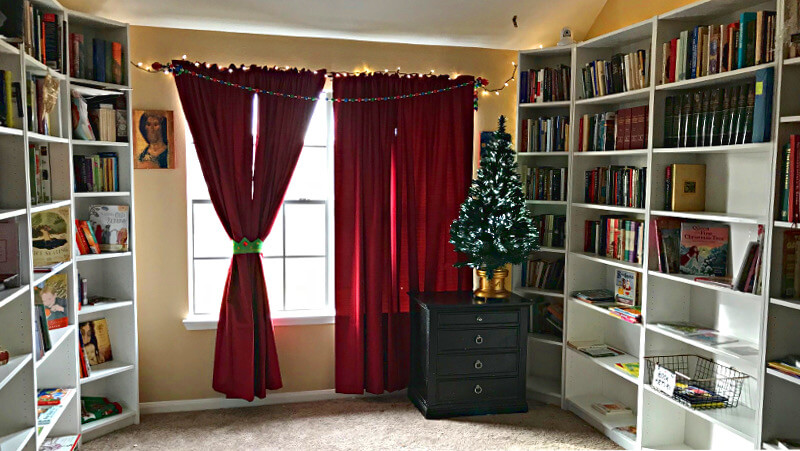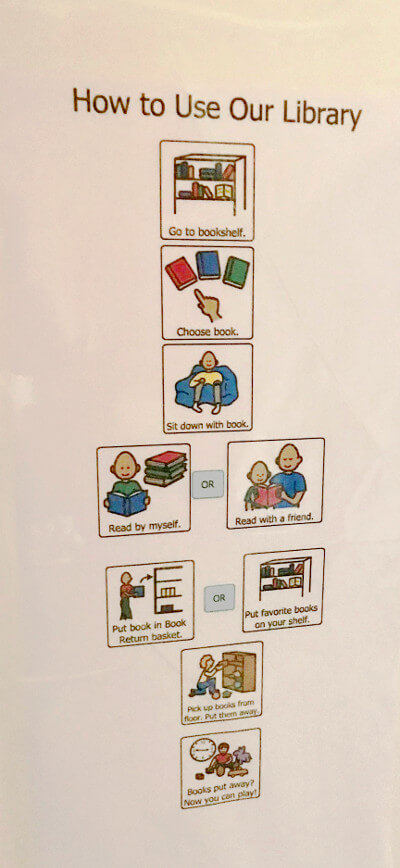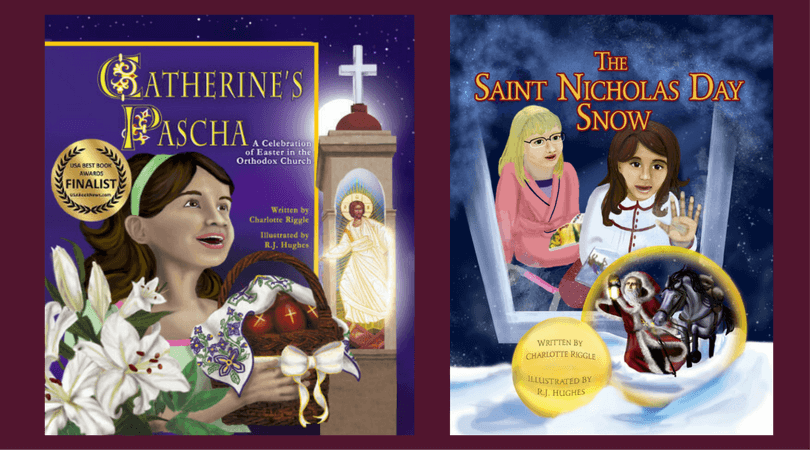When you love books, you want your children to love books, too. But Summer Kinard’s kids are particularly rough on books. Instead of hiding books away from them, she figured out how to make a home library that works for them.
Here, she explains the nine things she did to make her home library accessible to her autistic children. These tips aren’t just for autistic children, though. They can make a home library a more joy-filled place for any child.
Creating an autism-accessible home library
Guest post by Summer Kinard
When I was a little girl, my grandmother worked behind the scenes in our public library. I visited her often with my mother, and the ladies in Acquisitions would read me new books before they were put out on the shelves. To this day, the sound of a newly opened book delights me because of my fond memories of those years.
Naturally, I wanted to share my love of books and picture books with my children. But after my younger children were born, I quickly realized that I couldn’t share the joy of the public library with them. Because of sensory processing differences and apraxia, my younger children are rough with books, and one of my sons even eats them.
Looking at a library differently
For the past four years, I have tried to make books accessible to all of my children in our home instead. However, the usual tricks– seasonal rotation, book bins, front facing book racks — weren’t enough. My children would pour or toss the books on the floor.
That is, until I realized that I needed to look at the library from a therapeutic standpoint.
When I began to ask how our home library looks to a child who doesn’t immediately understand hidden rules, I saw the overwhelm at once. It took me a few days, but with these few small changes, our library is now accessible to the entire family.
ONE: Personal shelves
For each family member, I set aside a shelf labeled with their photo. This is where they can store their books in progress or their favorites. This practice cuts way back on anxiety for my children who were prone to knocking all of the books off of shelves, because they can now easily find the books they like the most.
TWO: Book return bin
I opted for a wire basket because it’s very sturdy and allows everyone to see the contents. Other options that might work well include clear acryllic trays or transparent storage bins without a lid.
I labeled the bin “Book Return” and attached the label with binder rings. The children feel secure in knowing that they have a place to put books they no longer want to look at or read.
Having a place designated to receive books when the children are finished has drastically cut down on books left on the floor. This helps in a second way, because the visual cue of books on the floor often triggers the children to throw more books on the floor.
THREE: Visual how-to chart
I created a visual chart to show my children how to use the library. I made two copies of the chart, and I posted it on the ends of bookcases on either side of the room.
You can download the visual chart here. Tape pages 1 and 3 together into a vertical flow chart. You can laminate them or tape them up, but make sure to put the first and third page together. I put mine up with clear contact paper.
Page 2 of the downloadable is a set of cards to print out and have available. If your child has limited verbal ability, these cards allow the child to tell you they want to read with you.
FOUR: Photos of people enjoying the library appropriately
In our family, we have large foam-filled beanbags for reading. I snapped a photo of several members of the family reading books alone or together while sitting on the beanbags. This shows my children what is expected.
FIVE: Open shelves with only one or two books on them
By leaving empty spaces to examine books interspersed with more dense book stacks, the children no longer feel the need to clear shelves in cataclysmic ways to focus on a book that interests them.
SIX: Toys intermingled in seasonal book displays
Since several of our favorite winter or Christmas stories feature mice, for instance, I put some of the Calico Critter mice on a shelf adjacent to the holiday books. We also display our child-friendly Nativity play sets on shelves next to the Christmas books. Having related toys gives the children ways to physically process their interest in the books without damaging the books through rough play.
SEVEN: Lighting choices
We installed white twinkle lights above the bookcases to provide ambient light. We have blackout curtains over the window that can be opened in the day to allow more light if we choose. The overhead lights are color and brightness adjustable. We hope to add wall lamps for another lighting option in the spring, but for now, our Christmas tree provides light as well.
EIGHT: Noise-blocking headphones
We set out noise-blocking headphones on reachable shelves. Part of the joy of the library is quiet, but sometimes quiet needs a little help.
NINE: Coziness
Parents with special needs children might already be familiar with the many senses that need to be integrated and supported: sight, hearing, taste, smell, touch, kinesthesis, vestibular, proprioception, temperature. But we also need to provide for the sense of coziness.
Okay, coziness is not a separate sense, but providing a space with softness, shelter, and warmth goes a long way towards helping children self-regulate and self-soothe. We have library blankets that we toss in the dryer for 5 minutes and bring out for reading time. There’s a closet off our library that we’re turning into a reading cave with crib mattresses and soft pillows on the floor as well. If you don’t have a reading closet or beanbags, you might use a play tent for the purpose.
The results of an accessible library
Now that my library system has been in place for a couple of months, the children almost never toss or dump whole shelves of books on the floor. In fact, I find even the older children reading more often.
I firmly believe that one of the gifts of autism is thinking through external spaces. This rearranged library opens the possibility of working out ideas in that space. That’s a beautiful gift, because the stories in the books will have a place to go in the children’s mind maps of the world.
About Summer Kinard
Summer is a Greek Orthodox Christian, the mother of five autistic children, a tea lover, classically trained soprano, and author of inspiring novels and curricula for active learners. She writes about the practicalities of autistic and spiritual life on her Facebook page and on her website. She’s currently writing Of Such is the Kingdom: A Practical Theology of Disability, a book that will show a way of welcoming persons and families with disabilities into the Orthodox Christian Church that is grounded in the heart of God.
Read More
Loving an autistic child at church: How does an autistic child in the church grow up to be an autistic adult in the church? Love.
Of Such is the Kingdom: A Practical Theology of Disability by Summer Kinard: This book is essential reading for church school teachers, pastoral staff, and parents who are teaching matters of faith and knowledge to children with disabilities.
Everything Tells Us About God: An autism-accessible book: A conversation between me and Summer Kinard about a picture book about God.
Buy the Books!
Catherine’s Pascha
FINALIST IN THE 2015 USA BEST BOOK AWARDS
Catherine doesn’t like vegetables. She doesn’t like naps. She doesn’t like it when her mom combs her hair. She loves hot dogs, chocolate cake, and her best friend, Elizabeth. Most of all, she loves Pascha! Pascha, the Orthodox Christian Easter, is celebrated in the middle of the night, with processions and candles and bells and singing. And Catherine insists that she’s not a bit sleepy.
Celebrate the joy of Pascha through the magic of a book: Catherine’s Pascha. Available on Amazon, Bookshop.org, and my webstore.
The Saint Nicholas Day Snow
Shoes or stockings? Horse or sleigh? Does St. Nicholas visit on December 6 or on Christmas Eve? Will a little girl’s prayer be answered? When Elizabeth has to stay at Catherine’s house, she’s worried about her grandmother, and worried that St. Nicholas won’t find her. The grownups, though, are worried about snow.
Celebrate the wonder of St. Nicholas Day through the magic of a book: The Saint Nicholas Day Snow. Available on Amazon, Bookshop.org, or my webstore.








